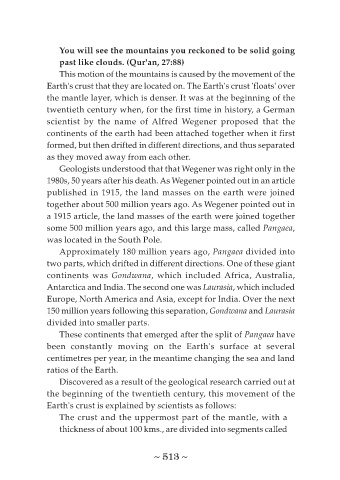Page 488 - Learning from the Qur'an
P. 488
You will see the mountains you reckoned to be solid going
past like clouds. (Qur'an, 27:88)
This motion of the mountains is caused by the movement of the
Earth's crust that they are located on. The Earth's crust 'floats' over
the mantle layer, which is denser. It was at the beginning of the
twentieth century when, for the first time in history, a German
scientist by the name of Alfred Wegener proposed that the
continents of the earth had been attached together when it first
formed, but then drifted in different directions, and thus separated
as they moved away from each other.
Geologists understood that that Wegener was right only in the
1980s, 50 years after his death. As Wegener pointed out in an article
published in 1915, the land masses on the earth were joined
together about 500 million years ago. As Wegener pointed out in
a 1915 article, the land masses of the earth were joined together
some 500 million years ago, and this large mass, called Pangaea,
was located in the South Pole.
Approximately 180 million years ago, Pangaea divided into
two parts, which drifted in different directions. One of these giant
continents was Gondwana, which included Africa, Australia,
Antarctica and India. The second one was Laurasia, which included
Europe, North America and Asia, except for India. Over the next
150 million years following this separation, Gondwana and Laurasia
divided into smaller parts.
These continents that emerged after the split of Pangaea have
been constantly moving on the Earth's surface at several
centimetres per year, in the meantime changing the sea and land
ratios of the Earth.
Discovered as a result of the geological research carried out at
the beginning of the twentieth century, this movement of the
Earth's crust is explained by scientists as follows:
The crust and the uppermost part of the mantle, with a
thickness of about 100 kms., are divided into segments called
~ 513 ~

